
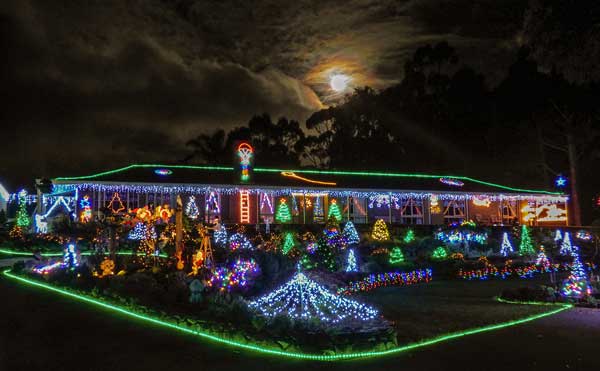
5 Christmas Lane, Lobethal, SA Australia.
(Photo Peg & Bill's collection Circa 2017 )

We live in Lobethal, South Australia, a small village in the
picturesque Adelaide Hills, about 40k South East of Adelaide, SA, AUSTRALIA, and began
our Christmas Display in 1983 with a single strand of festoon lights.
In 1986 we decided that we should "do a little more" so we began designing
and adding more features. By the mid 1990's the display covered about 1
acre and it was estimated that over 100,000 people actually entered our property each
year for a close up view.
In 2008, due to ill-health and the time and commitment that it took, we decided that we could no longer continue presenting our display.
However by 2012, our health had improved so we decided that we would put up a few lights, just for ourselves and family but not open the property to the public.
However this was not to be; Peg & I both suffer from that shocking disease "Christmaslightous" a terrible condition that makes you have to continue putting up lights once you start!
In just 6 days our front yard was again transformed into a magical light display (although much smaller than it was in previous years), and our windows again opened up to reveal more Christmas magic, and we decided that we should again open to the public to allow them to enjoy it with us.
This proved to be a very rewarding experience as we were amazed at the number of people that welcomed us "back" and said how much they had missed us.
In 2013 we increased the size of the display and decided that we should continue as an annual event.
In 2008, due to ill-health and the time and commitment that it took, we decided that we could no longer continue presenting our display.
However by 2012, our health had improved so we decided that we would put up a few lights, just for ourselves and family but not open the property to the public.
However this was not to be; Peg & I both suffer from that shocking disease "Christmaslightous" a terrible condition that makes you have to continue putting up lights once you start!
In just 6 days our front yard was again transformed into a magical light display (although much smaller than it was in previous years), and our windows again opened up to reveal more Christmas magic, and we decided that we should again open to the public to allow them to enjoy it with us.
This proved to be a very rewarding experience as we were amazed at the number of people that welcomed us "back" and said how much they had missed us.
In 2013 we increased the size of the display and decided that we should continue as an annual event.

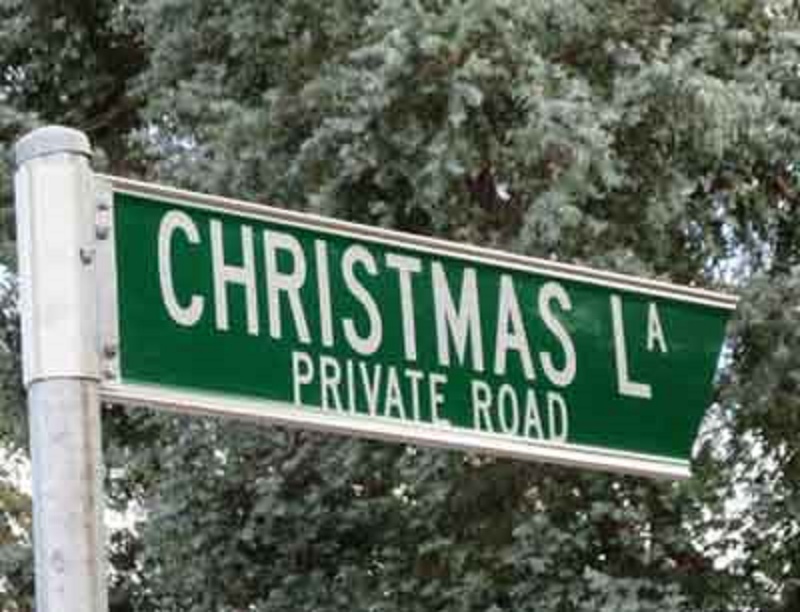
We subdivided our property and in February 2014 we received notification from the Adelaide Hills Council that they had named our driveway, which is now a private road, CHRISTMAS LANE.
We feel very honoured to have this recognition.
Whenever we tell people that our new address is 5 Christmas Lane it brings a smile to their face.

The tradition of
Lobethal's Christmas Lights began in the 1940's when a few business
men hand painted globes to decorate their Main Street shops for the Christmas season.This tradition spread and today about 80% of all homes and business in the village
"light up" for Christmas with a variety of spectacular displays.

The Lobethal Christmas Lights Display has become the largest Christmas Lights display
in South Australia, and possibly the largest community Christmas event in Australia.The Display runs from the second Sunday of December until New Years Eve each year.During The Display there are a variety of stalls, events, live entertainment and a market
to add to the spirit of the Display.

When we moved to Lobethal in December 1983 we followed the towns tradition of having a
few lights for Christmas by putting up a single strand of festoon lights
Peg had grown up in Cudlee Creek, just a few kilometres down the road, and had many fond memories of coming to Lobethal to see the lights as a child .
In 1986 we decided that we should do a bit more, so each year until 2008 we added to our display until it covered about one and a half acres.
Peg had grown up in Cudlee Creek, just a few kilometres down the road, and had many fond memories of coming to Lobethal to see the lights as a child .
In 1986 we decided that we should do a bit more, so each year until 2008 we added to our display until it covered about one and a half acres.

Our display became our passion and we spend about 6 months each year working on it.
During the year we designed and made new display items as well as maintaining the
old ones. We used to start erecting the display in October so as it would be ready
by the beginning of December, however in 2024 we decided to begin setting up in the first week of September as we are getting older and becoming slower. Our display runs throughout December and, after a
short break, we begin packing it up early in the New Year.


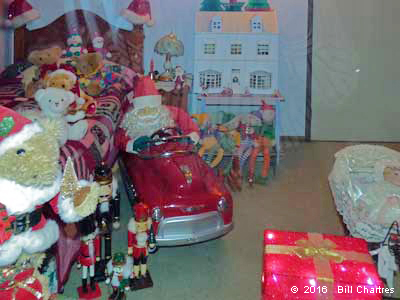 For Christmas 1995 we added a new feature, a Christmas Room,which contains "all things Christmas", including Christmas Collectables,
decorated Christmas Trees and other Christmas decorations.
For Christmas 1995 we added a new feature, a Christmas Room,which contains "all things Christmas", including Christmas Collectables,
decorated Christmas Trees and other Christmas decorations.Although not open to the public, The Christmas Room can be viewed through large windows.
In Christmas 2003 we added more Window Displays, then, in 2005 we included a Child's Bedroom Christmas Display for viewing.

As lights became more readily available the towns display grew and in the mid
1990's it was estimated that up to 250,000 people visited Lobethal's
Christmas Lights Display each year,and about 100,000 actually entered our property
for close up view of our display.

Each year we were asked the question ...
"How many lights are there?"
We believe that in 2007 we achieved our aim of reaching 100,000 lights.However now that we do a smaller display we think that there are more than 50,000 lights.
For more questions visit our FAQ Page.
"How many lights are there?"
We believe that in 2007 we achieved our aim of reaching 100,000 lights.However now that we do a smaller display we think that there are more than 50,000 lights.
For more questions visit our FAQ Page.

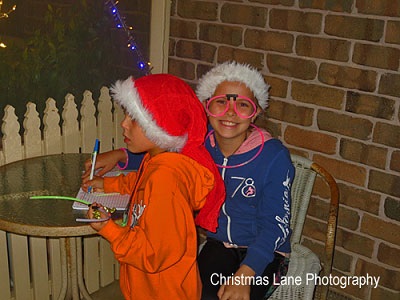
During the display we have visitors books for our guests to sign, and have had between 3,000 and 4,500 entries with visitors from as many as 35 different countries (in a single year), as well as all Australian States and Territories.

 Many people ask why we have a Noël sign. Since our surname is of French origin, we
thought that it would be nice to add a French touch to our display.
Many people ask why we have a Noël sign. Since our surname is of French origin, we
thought that it would be nice to add a French touch to our display.
Joyeux Noël. (Merry Christmas)
On 26th January 2022 Peg & I were honoured to receive a Civic Award, for presenting our Lights Display since 1983,
from the Adelaide Hills Council at the
Australia Day Ceremony held at Stirling.
The award was presented by Jan-Clair Wisdom, the Mayor of the AHC.

Presentation Video
(Double Click to view,
then press Esc to return to page)
(time 1:55 minutes)
Thanks to our son
Wayne for this video.

Photos of our Christmas Lights Display

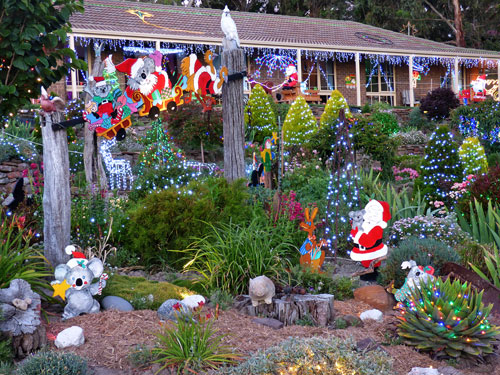
Australiana display .
(Photo Peg & Bill's collection 2020)
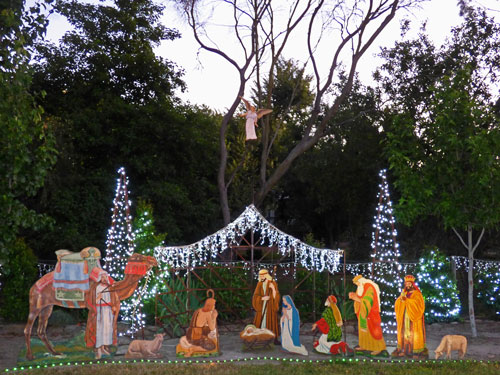
Nativity display .
(Photo Peg & Bill's collection 2020)
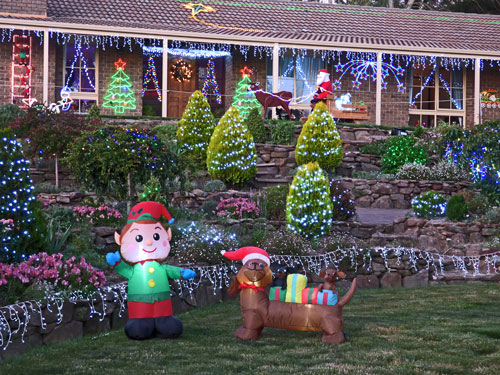
Elf and dachshund display
(Photo Peg & Bill's collection 2020)


Elf display.
(Photo Peg & Bill's collection 2020)
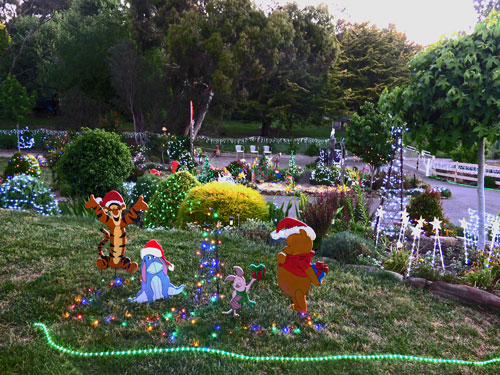
Pooh display
(Photo Peg & Bill's collection 2020)
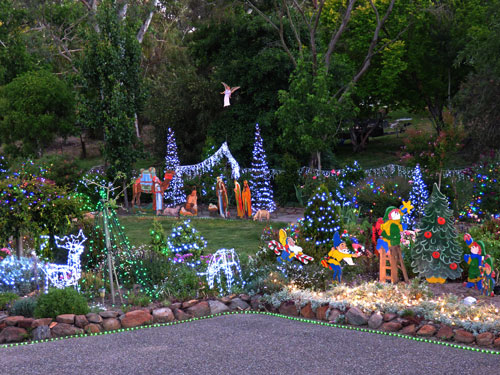
Display .
(Photo Peg & Bill's collection 2020)


Christmas is the Time of Year When Heaven Touches Earth (Anon.)
Videos
Click to view small, Double Click to view Full Screen.
Click esc to return to this page if full Screen.
Santa's lights
(time 0:37 minutes)
Santa's ladder
(time 0:50 minutes)
Singing and dancing Santa
(time 1:18 minutes)
Our 2019 Display
(time 4:46 minutes)
It was fortunate that I took a
video of our 2019 display
earlier than usual. This will
always be a favourite video
of ours as it brings back
good
memories of an extremely
difficult, and stressful,
time. We hope you enjoy
it as much as we do.
(time 4:46 minutes)
It was fortunate that I took a
video of our 2019 display
earlier than usual. This will
always be a favourite video
of ours as it brings back
good
memories of an extremely
difficult, and stressful,
time. We hope you enjoy
it as much as we do.
Inside displays 2015
(time 6:08 minutes)
In 1995 Peg added an
inside display which
could be viewed
through windows.
Over the next few
years Peg added
more inside displays
and we now have 7
window displays.
(time 6:08 minutes)
In 1995 Peg added an
inside display which
could be viewed
through windows.
Over the next few
years Peg added
more inside displays
and we now have 7
window displays.
Old video of our display in
the 1980's
(time 5:04 minutes)

Visit us on FaceBook.